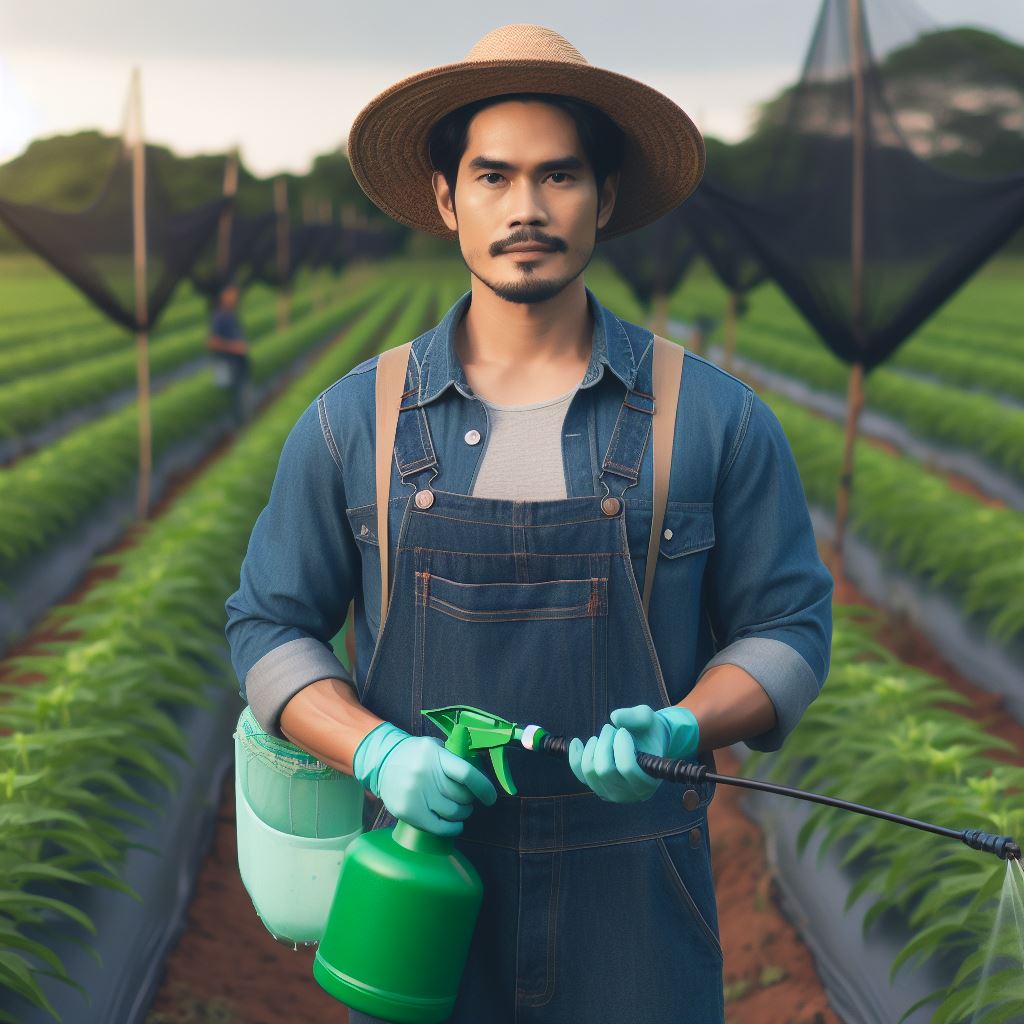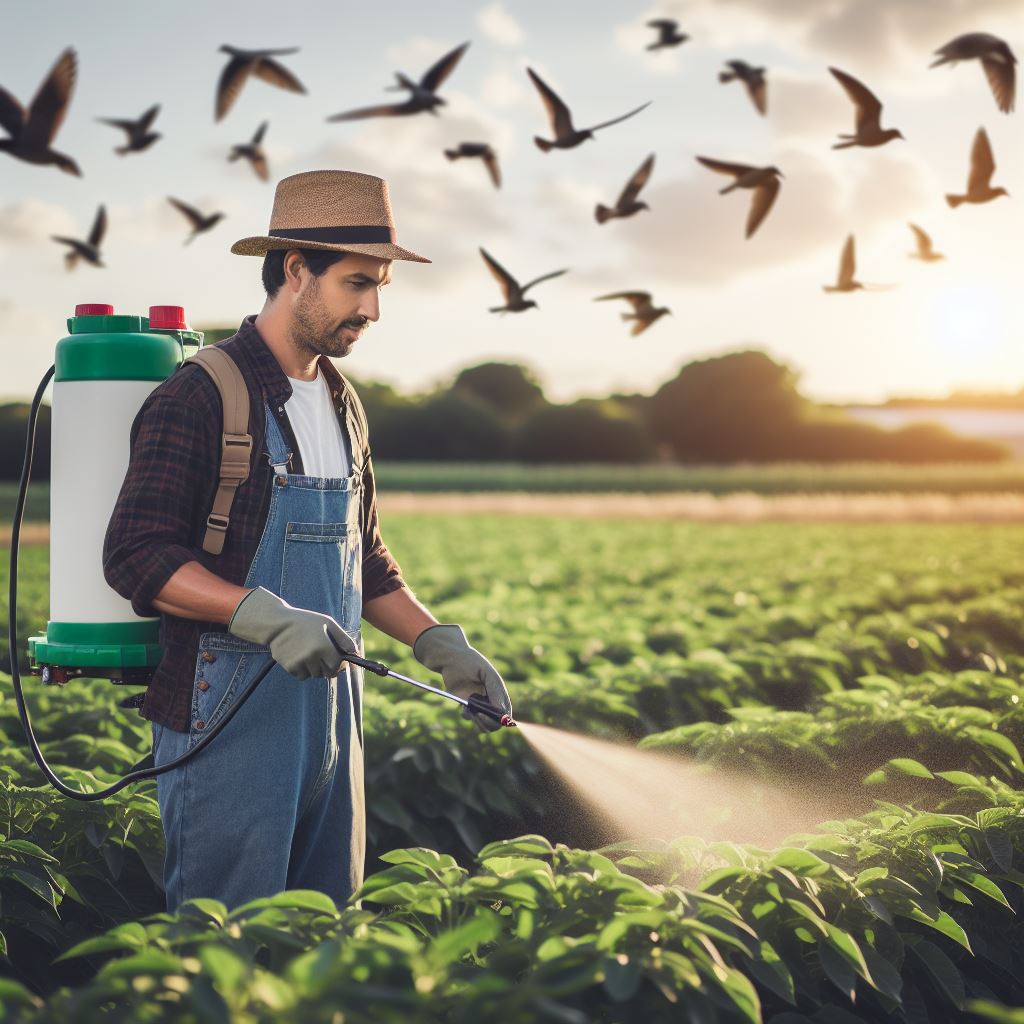Introduction
A. Definition of integrated pest management (IPM)
Integrated Pest Management (IPM) is a holistic approach to managing pests in crops.
Pest problems have always been a challenge in crop farming.
Farmers constantly search for effective methods to protect their crops from pests while minimizing negative impacts on the environment and human health.
This is where Integrated Pest Management (IPM) comes into play.
IPM is a comprehensive approach to pest control that aims to combine various strategies to manage pests effectively.
It involves the use of biological, cultural, physical, and chemical methods to control pests, taking into account their life cycles, interactions, and overall impact on the crop.
B. Importance of IPM for crop farming
IPM is crucial for crop farming as it minimizes the use of synthetic pesticides.
The importance of IPM in crop farming cannot be overstated.
It helps reduce the reliance on synthetic pesticides, which can have harmful effects on beneficial insects, soil health, and water quality.
By utilizing IPM techniques, farmers can better protect their crops from pests, minimize pesticide use, and ensure sustainable agriculture practices.
C. Purpose of the blog post
The purpose of this blog post is to shed light on the importance and benefits of IPM in agriculture.
The purpose of this blog post is to create awareness about IPM and its benefits for crop farming.
Through understanding and implementing IPM, farmers can achieve better pest control, enhance crop resilience, and improve overall farm productivity.
Furthermore, IPM contributes to the preservation of biodiversity and reduces the risk of pesticide resistance.
In the following sections, we will delve deeper into the various components of IPM, explore its benefits, and provide practical tips for farmers interested in implementing IPM strategies.
Transform Your Agribusiness
Unlock your farm's potential with expert advice tailored to your needs. Get actionable steps that drive real results.
Get StartedStay tuned to unlock the potential of Integrated Pest Management in your crop farming journey.
Understanding Pest Management
A. Definition of pests in crop farming
Pests in crop farming refer to organisms that cause harm or damage to crops, affecting their growth and productivity.
B. Negative impact of pests on crop yield and quality
Pests can lead to significant reductions in crop yield and quality, resulting in economic losses for farmers and food shortages for communities.
C. Traditional pest management approaches
- Synthetic pesticides: Chemical-based insecticides and herbicides are commonly used to control pests in crop farming.
- Biological control: Natural enemies of pests, such as predators and parasites, are introduced to reduce pest populations.
- Cultural practices: Crop rotation, proper irrigation, and weed control are employed to minimize pest infestations.
- Genetic resistance: Developing crops with enhanced resistance to pests through selective breeding or genetic manipulation.
- Physical barriers: Nets, fences, or traps are used to physically prevent pests from reaching crops.
D. Limitations of traditional approaches
- Environmental impact: Synthetic pesticides can have detrimental effects on beneficial organisms, water sources, and soil health.
- Resistant pest populations: Prolonged use of synthetic pesticides can lead to the emergence of pesticide-resistant pest species.
- Health risks: Excessive exposure to pesticides can pose health risks to farmers, farmworkers, and consumers.
- Cost: Traditional pest management approaches can be expensive due to the reliance on chemical inputs and labor-intensive practices.
- Lack of long-term sustainability: Traditional approaches often focus on short-term pest control rather than ecological balance.
In response to these limitations, Integrated Pest Management (IPM) emerged as a holistic and sustainable approach to pest management in crop farming.
Read: Composting: Organic Nutrient Powerhouse
Introduction to Integrated Pest Management (IPM)
A. Definition of Integrated Pest Management (IPM)
Integrated Pest Management (IPM) is a science-based approach that combines various pest control methods to minimize pests’ impact while reducing reliance on synthetic chemical pesticides.
B. Principles of Integrated Pest Management (IPM)
- Monitoring and identification: Regular monitoring of pest populations and identification of specific pests help in determining appropriate control measures.
- Prevention: Implementing preventive measures, such as crop rotation, sanitation, and use of pest-resistant varieties, to minimize pest infestations.
- Cultural practices: Emphasizing cultural practices that promote overall plant health, such as proper irrigation, nutrient management, and habitat manipulation.
- Biological control: Encouraging and enhancing the presence of natural enemies to regulate pest populations.
- Chemical control: If necessary, judicious use of chemical pesticides, considering their potential risks and selecting environmentally friendly options.
- Integration and evaluation: Integrating various pest control methods and regularly evaluating their effectiveness to adjust strategies accordingly.
C. Benefits of Integrated Pest Management (IPM)
- Reduced environmental impact: IPM emphasizes the use of non-chemical control methods, minimizing harmful effects on ecosystems and biodiversity.
- Lower pesticide usage: IPM focuses on reducing reliance on synthetic pesticides, promoting the use of alternative pest control methods.
- Cost-effectiveness: By targeting specific pests and minimizing unnecessary pesticide applications, IPM can reduce production costs for farmers.
- Human health protection: IPM aims to minimize human exposure to harmful pesticides, safeguarding the health of farmers, farmworkers, and consumers.
- Long-term sustainability: IPM fosters ecological balance, promoting the development of resilient and sustainable farming systems.
To summarize, Integrated Pest Management (IPM) provides a comprehensive and sustainable approach to pest management in crop farming.
By incorporating various pest control methods and prioritizing ecological balance, IPM offers benefits such as reduced environmental impact, decreased pesticide usage, cost-effectiveness, and human health protection.
Implementing IPM strategies can help ensure crop yield and quality while safeguarding the long-term sustainability of agricultural systems.
Read: Soil Testing: Key to Effective Fertilization
Principles of Integrated Pest Management
A. Prevention as the first line of defense
Prevention plays a crucial role in the success of Integrated Pest Management (IPM) for crops.
By implementing a range of preventive measures, farmers can effectively keep pests at bay.
Regularly inspecting crops for signs of pests can help in early detection.
Proper sanitation, such as removing crop residues, can eliminate pest hiding places.
Implementing good cultural practices, like crop rotation and choosing resistant varieties, can prevent pest infestations.
Using physical barriers like nets and fences can also act as deterrents for pests.
Providing favorable habitat for beneficial insects can aid in natural pest control.
B. Identification and monitoring of pests
Accurate identification and monitoring of pests is essential in implementing effective IPM strategies.
Identifying the specific pest species helps in determining appropriate control measures.
Regular monitoring of pest populations allows farmers to gauge the extent of the problem.
Monitoring also helps determine if the pest populations are reaching economic thresholds.
Using pest traps and visual observations can aid in monitoring pest populations.
Tracking changes in pest populations over time helps in making informed decisions.
C. Threshold determination for pest control interventions
Setting proper thresholds for pest control interventions ensures timely and effective action.
Showcase Your Farming Business
Publish your professional farming services profile on our blog for a one-time fee of $200 and reach a dedicated audience of farmers and agribusiness owners.
Publish Your ProfileThresholds are the pest population levels at which action is necessary to prevent yield loss.
Economic thresholds consider the cost of control measures against potential crop damage.
By establishing thresholds, farmers can optimize their resources and minimize pesticide use.
Threshold determination is influenced by economic, environmental, and social factors.
Regular monitoring helps in accurately determining if the thresholds have been exceeded.
D. Utilization of multiple pest control tactics
IPM emphasizes the use of diverse pest control tactics for better long-term pest management.
Biological control involves using natural enemies like predator insects and pathogens.
Mechanical control methods, such as trapping or handpicking, physically remove pests.
Cultural control practices, like crop rotation and intercropping, reduce pest populations.
Chemical control should be used as a last resort and targeted only to specific pests.
Integrating different tactics enhances control efficacy and minimizes resistance development.
E. Evaluation and adjustment of IPM strategies
Regular evaluation and adjustment of IPM strategies ensure continuous improvement and effectiveness.
Regular assessment of pest management practices helps identify areas that need improvement.
Collecting data on pest populations, crop damage, and control measures is crucial for evaluation.
Analyze the efficacy of each tactic used to control pests and make necessary adjustments.
Farmer feedback and experience contribute to refining IPM strategies over time.
Stay updated with new research and innovations in pest management for better outcomes.
Integrated Pest Management for crops follows principles such as prevention, identification and monitoring, threshold determination, utilization of multiple control tactics, and evaluation and adjustment of strategies.
By understanding and implementing these principles, farmers can effectively manage pests while minimizing reliance on chemical controls.
Read: Boosting Yield with Crop Choice

Components of Integrated Pest Management
Integrated Pest Management (IPM) combines various strategies to manage pests in a holistic and sustainable manner.
By utilizing different components, farmers can reduce reliance on chemical pesticides and mitigate environmental damage while maintaining crop productivity.
A. Cultural control methods
Cultural control methods form the foundation of IPM.
1. Crop rotation
Rotating crops helps break the life cycles of pests, reducing their populations.
Crop rotation, the practice of alternately planting different crops on the same land, disrupts pest life cycles.
The pests that prey on one crop are left without a suitable host, reducing their numbers.
2. Tilling and mulching
Regular tilling disturbs pest habitats, while mulching suppresses weed growth.
Additionally, tilling and mulching help control pests. Regular tilling disturbs the habitats of pests, making it harder for them to establish and reproduce.
Mulching, on the other hand, suppresses weed growth, which can serve as a habitat and food source for pests.
3. Water management
Proper irrigation helps optimize plant health, making them less susceptible to pests.
Water management plays a crucial role in IPM. Proper irrigation ensures crop health and minimizes stress, making plants more resistant to pests.
Over-irrigation can lead to waterlogged soils, favoring the development of certain pests.
On the other hand, under-irrigation can weaken plants, making them more susceptible to pests. Finding the right balance is key.
4. Trap cropping
Planting attractive crops near the main crop lures pests away, protecting the valuable plants.
Trap cropping is another cultural control method.
By planting attractive crops near the main crop, pests are lured away from the valuable plants.
The trap crops serve as a sacrificial offering, protecting the primary crop from damage.
This method is particularly effective for controlling pests that have specific preferences.
B. Biological control methods
1. Introduction of natural enemies
Releasing predators or parasites that feed on pests helps control their populations.
Biological control methods involve the use of natural enemies to control pests.
Showcase Your Farming Business
Publish your professional farming services profile on our blog for a one-time fee of $200 and reach a dedicated audience of farmers and agribusiness owners.
Publish Your ProfileIntroducing predators or parasites that feed on pests can help regulate their populations.
For instance, ladybugs are released to control aphids, as they feed on these harmful insects.
2. Conservation of natural enemies
Providing habitats or food sources for beneficial insects encourages their presence.
Creating habitats or providing food sources for beneficial insects can also help maintain predator populations.
This ensures a continuous supply of natural enemies to control pests.
3. Microbial pesticides
Using bacterial or fungal organisms that are harmful to pests aids in pest control.
Microbial pesticides are another biological control method. Rather than using chemical pesticides, microbial organisms are employed to target specific pests.
These organisms, such as bacteria or fungi, can infect and kill pests without harming the environment or non-target organisms.
C. Chemical control methods
Chemical control methods, although not the primary focus of IPM, can still be utilized judiciously.
1. Judicious use of pesticides
Applying pesticides only when necessary minimizes their impact on the environment.
The judicious use of pesticides involves applying them only when necessary, based on monitoring and economic thresholds.
This minimizes the negative impacts on the environment, including the risk of pesticide resistance.
2. Selection of pesticides based on efficacy and environmental impact
Choosing the right pesticide ensures effective control with minimal harm.
Careful selection of pesticides is also essential.
Farmers should choose products that are effective against the target pest while having minimal impact on non-target organisms and the environment.
3.
Proper application techniques
Following correct dosages, timing, and methods of pesticide application ensures maximum efficiency.
Proper application techniques, such as following correct dosages and using appropriate equipment, further ensure effective control.
In essence, the components of Integrated Pest Management work together to provide an effective and sustainable approach to pest control.
By using cultural, biological, and chemical methods in harmony, farmers can reduce pest populations, protect crop yields, and safeguard the environment.
Read: Optimizing Crop Rotation Tips
Benefits of Integrated Pest Management
A. Reduced pesticide usage
Using Integrated Pest Management (IPM) techniques allows farmers to minimize their reliance on pesticides.
IPM emphasizes the use of biological control methods such as natural predators, parasites, and pathogens.
By using these methods, farmers can significantly reduce the amount of chemical pesticides needed for crop protection.
B. Enhanced ecosystem health
IPM promotes a healthy and balanced ecosystem by minimizing the negative impact of pesticides on beneficial organisms.
Chemical pesticides can harm non-target organisms and disrupt the natural balance of the ecosystem.
With IPM, farmers can protect their crops while ensuring the overall health of the ecosystem.
C. Preservation of beneficial insects
One of the key elements of IPM is the conservation and preservation of beneficial insects.
These insects act as natural predators, feeding on pests and helping to control their populations.
By promoting their habitat and reducing pesticide usage, IPM allows beneficial insects to thrive and contribute to pest control.
D. Improved crop quality and yield
IPM practices focus on monitoring pest populations and taking action before they reach damaging levels.
By implementing timely interventions, farmers can prevent significant crop damage, ensuring better yield and quality.
Regular scouting and early detection help identify pest problems in their early stages, leading to effective management.
E. Long-term sustainability for farming operations
IPM encourages the adoption of sustainable farming practices that reduce the environmental impact of agriculture.
By reducing pesticide usage, conserving beneficial insects, and promoting ecosystem health, IPM ensures the long-term viability of farming operations.
This approach minimizes the risk of pest resistance and helps maintain agricultural productivity for future generations.
Essentially, Integrated Pest Management offers numerous benefits to crop production.
By reducing pesticide usage, promoting ecosystem health, preserving beneficial insects, and improving crop quality and yield, IPM provides a sustainable and effective approach to pest management.
Learn More: Futuristic Farm Tools: Tomorrow’s Agriculture
See Related Content: Maximizing Yields with Organic Fertilizers
Find Out More: Maximizing Yield with Minimal Water Use
Challenges and Considerations for Integrated Pest Management
A. Initial investment and training requirements
- Integrated Pest Management (IPM) for crops requires significant initial investment in infrastructure and equipment.
- Farmers need training on IPM techniques, which may involve additional costs for workshops or courses.
- Investing in the necessary tools and equipment can be a major financial burden for small-scale farmers.
- Adequate training ensures farmers understand the principles of IPM and effectively implement the strategies.
B. Regular monitoring and data collection
- IPM requires continuous monitoring and data collection to assess pest populations and make informed decisions.
- Farmers need to regularly inspect their crops and collect data on pest prevalence, crop damage, and beneficial organisms.
- Monitoring can be time-consuming and labor-intensive, especially for large farms.
- Data collection helps identify pest trends, effectiveness of control methods, and make adjustments accordingly.
C. Cooperation among farmers and stakeholders
- Successful IPM implementation often requires collaboration and cooperation among farmers, extension services, and other stakeholders.
- Farmers must communicate and work together to tackle pest management challenges collectively.
- Sharing knowledge and experiences can enhance the overall effectiveness of IPM strategies.
- Building relationships and establishing networks facilitate the exchange of valuable information and support.
D. Potential resistance or resurgence of pests
- Continuous use of pesticides can lead to the development of resistance in pests over time.
- Resistant pests pose a significant challenge to IPM, as they are less susceptible to management tactics.
- Changing pest populations and environmental factors can result in pest resurgence, requiring adaptive strategies.
- Integrated approaches that target multiple aspects of pest control reduce the risk of resistance and resurgence.
E. Economic implications for farmers
- Implementing IPM strategies may require additional investments and resources, impacting farmers’ profitability.
- The upfront costs of infrastructure, training, and equipment can strain the financial resources of farmers.
- However, long-term benefits, such as reduced pesticide use and potential yield increases, can outweigh the initial expenses.
- Government subsidies, grants, and support programs can help alleviate the economic burden on farmers adopting IPM.
Generally, Integrated Pest Management for crops faces various challenges and considerations.
Farmers need to overcome initial investment barriers, invest in training, and establish robust monitoring and data collection systems.
Cooperation, collaboration, and knowledge sharing among farmers and stakeholders enhance the effectiveness of IPM.
The threat of resistance and resurgence of pests necessitates adaptive strategies.
While implementing IPM may have economic implications, long-term benefits justify the investment.
By addressing these challenges, farmers can successfully employ IPM practices to ensure sustainable crop production.
See Related Content: Sustainable Weed Control for Crop Health
Success Stories and Case Studies
A. Examples of successful implementation of IPM
- In a study in California, IPM reduced pesticide use in cabbage by 90% while maintaining yield levels.
- Farmers in India successfully used IPM techniques to control pests in cotton crops, leading to increased profit margins.
- The implementation of IPM strategies in rice farms in Thailand resulted in higher crop yields and reduced chemical inputs.
- A group of grape farmers in Argentina adopted IPM, which resulted in improved grape quality and reduced reliance on pesticides.
- In Denmark, IPM practices were successfully employed in apple orchards, leading to enhanced biodiversity and reduced pest damage.
B. Positive outcomes for farmers and the environment
- By reducing dependence on chemical pesticides, IPM helps farmers save costs on purchasing expensive agrochemicals.
- Increased crop yields through IPM contribute to improved food security and farmers’ income.
- IPM minimizes detrimental effects on non-target organisms, preserving the overall ecosystem health.
- Health risks for farmers and workers are reduced as they are exposed to fewer hazardous chemicals.
- A sustainable farming approach, IPM promotes long-term environmental and economic stability.
C. Lessons learned from different regions and crops
- The successful implementation of IPM techniques requires proper training and knowledge transfer to farmers.
- Tailoring IPM practices to specific regional conditions and crop requirements is crucial for optimal results.
- Collaborative efforts between farmers, researchers, and extension services are essential for effective IPM adoption.
- Regular monitoring and scouting for pests and diseases provide early detection and timely intervention.
- Farmer education and awareness programs play a vital role in facilitating IPM adoption and its long-term success.
Conclusion
A. Recap of the importance and benefits of IPM for crop farming
Integrated Pest Management (IPM) is invaluable for crop farming.
By utilizing various strategies such as biological control, cultural practices, and chemical control, IPM promotes sustainable and environmentally friendly pest management.
This approach reduces reliance on harmful pesticides and minimizes the risk of pests developing resistance.
B. Encouragement for farmers to adopt integrated pest management practices
Farmers are strongly encouraged to embrace IPM practices.
By implementing IPM, farmers can protect their crops from pests effectively while reducing costs associated with pesticide use.
Showcase Your Farming Business
Publish your professional farming services profile on our blog for a one-time fee of $200 and reach a dedicated audience of farmers and agribusiness owners.
Publish Your ProfileIPM also helps maintain soil health, conserve biodiversity, and safeguard the environment for future generations.
C. Call to action for stakeholders to support and promote IPM implementation
Stakeholders, including government agencies, agricultural organizations, and consumers, play a vital role in facilitating the widespread adoption of IPM.
It is crucial to provide educational resources, financial incentives, and regulatory support to encourage farmers to adopt IPM practices.
Consumers can support IPM by choosing sustainably produced agricultural products and spreading awareness about the benefits of IPM.
Let us join hands and promote the use of integrated pest management for crop farming.
By working together, we can protect crops, preserve the environment, and ensure a sustainable future for agriculture. Together, we can make a difference.




